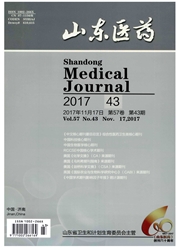

 中文摘要:
中文摘要:
摘要:目的探讨三水白虎汤(SSBH)对类风湿关节炎(RA)滑膜成纤维细胞(FLS)增殖的蛋白质组学影响。方法组织块培养法收集RA患者的关节FLS,体外传代培养,取3~6代细胞,分别加入SSBH含药血清培养(SSBH组)及加入生理盐水制备的血清培养(对照组)。培养72h后提取细胞总蛋白,用双向凝胶电泳(2-DE)分离细胞总蛋白,凝胶经银染显色和图像数据分析识别差异蛋白位点;基质辅助激光解析电离飞行时间质谱对差异蛋白位点进行鉴定。结果两组FLS蛋白2-DE图谱均出现差异蛋白质点。在差异蛋白表达量超过3倍的蛋白质点中,选取27个差异蛋白位点进行质谱分析,共鉴定出包括表达上升的IL-1受体拮抗蛋白等25种蛋白质。结论SSBH可能通过上调RA患者FLS中IL-1受体拮抗蛋白来抑制滑膜增生,这可能是该方剂治疗RA的药理作用机制之一。
 英文摘要:
英文摘要:
Objective To investigate the effects of the traditional Chinese medicine SanShui BaiHu decoction(SSBH) on the proteomics changes of fibroblast-like synoviocytes (FLS) derived from the rheumatoid arthritis (RA). Methods A total of 20 adult male SD rats were randomly divided into two groups, 10 rats in each group. 1 week later, the blood of the rats from abdominal aorta were collected and then centrifugated to obtain the serum. Tissues collected from rheumatoid ar- thritis(RA) patients were primary cultured in routine culture medium to obtain fibroblast-like synoviocytes (FLS). FLS subcuhured for 3-6 generation were cultured in DMEM with 20% serum containing SSBH as the SSBH group, and normal saline in the control group. 72 h later, the total cell protein was extracted and separated by two-dimensional electrophoresis (2-DE). The differential protein sites were analyzed by the silver stained gels and PDQUEST, and the differential protein sites were identified by matrix-assisted laser desorption ionization-time of flight mass spectrometry (MALDI-TOF). Results Twenty-seven highly expressed protein spots were selected through comparing the two-dimensional electrophoresis images between the SSBH group and the control group, whose expression quantities were more than 3 times higher than the control group, and they were analyzed by mass spectrometry. In the SSBH group, there were totally 25 kinds of protein over ex- pressed including the IL-1 receptor antagonist protein. Conclusion The traditional Chinese medicine SanShui BaiHu de- coction(SSBH) could inhibit the proliferation of the fibroblast-like synoviocytes(FLS) through up-regulating the expression of the IL-1 receptor antagonist protein, which may be one of the pharmacological mechanisms of the SSBH in treating RA.
 同期刊论文项目
同期刊论文项目
 同项目期刊论文
同项目期刊论文
 期刊信息
期刊信息
